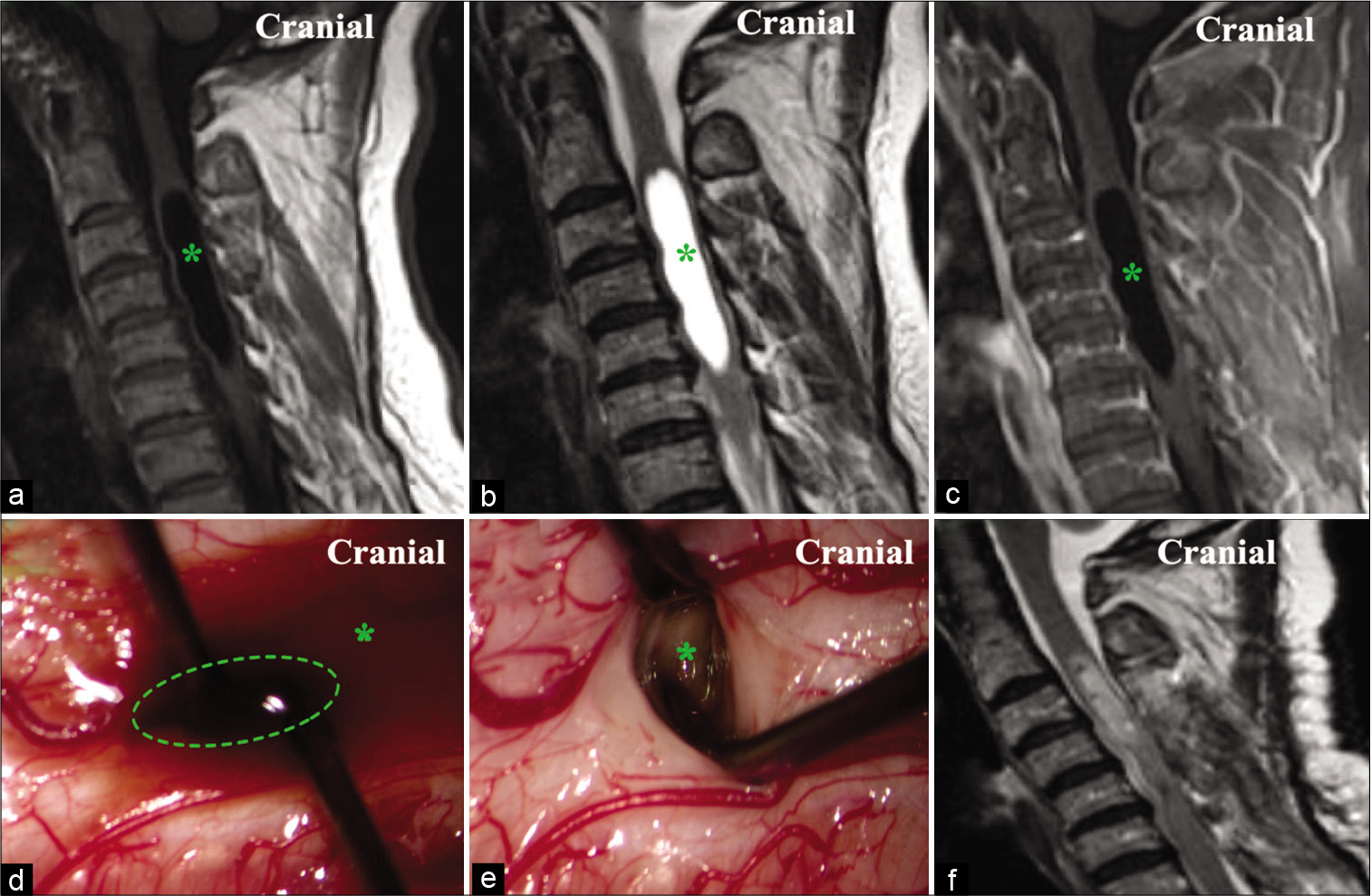- Department of Neurosurgery, University of Washington, Seattle, Washington, United States.
- Department of Neurosurgery, University of Louisville, Louisville, Kentucky, United States.
Correspondence Address:
Zaid Aljuboori, Department of Neurosurgery, University of Washington, Seattle, Washington, United States.
DOI:10.25259/SNI_737_2021
Copyright: © 2021 Surgical Neurology International This is an open-access article distributed under the terms of the Creative Commons Attribution-Non Commercial-Share Alike 4.0 License, which allows others to remix, tweak, and build upon the work non-commercially, as long as the author is credited and the new creations are licensed under the identical terms.How to cite this article: Zaid Aljuboori1, Brian Williams2. Spinal intramedullary hematoma presenting years following a cervical epidural injection. 30-Aug-2021;12:430
How to cite this URL: Zaid Aljuboori1, Brian Williams2. Spinal intramedullary hematoma presenting years following a cervical epidural injection. 30-Aug-2021;12:430. Available from: https://surgicalneurologyint.com/surgicalint-articles/11079/
Abstract
Background: Intramedullary cervical cystic lesions are typically attributed to tumors, infection, or trauma. Here, a patient newly presented with quadriparesis due to a chronic cervical intramedullary hematoma attributed to a cervical epidural steroid injection (CESI) performed 4 years earlier.
Case Description: A 38-year-old patient had a CESI in 2014. Resulting in a transient quadriparesis attributed to an inadvertent intramedullary cord injection. Now, at age 42, she presented with a recurrent cervical myelopathy due to an MR-documented C3-C6 intramedullary cystic lesion that at surgery proved to be a chronic liquified hematoma rather than a syrinx.
Conclusion: CESI can result in inadvertent intramedullary hemorrhages and spinal cord injuries. Here, a 42-year-old female presented with recurrent myelopathy due to a chronic intramedullary C3-C6 cervical hematoma attributed a prior intramedullary CESI injection performed 4 years previously.
Keywords: Epidural, Injection, Intramedullary, Hematoma, Spine
INTRODUCTION
Intramedullary cervical cystic lesions are typically attributed to; intramedullary tumors, syringomyelia, hematomyelia, and intramedullary abscesses.[
CASE DESCRIPTION
A now 42-year-old patient underwent a CESI for neck pain in 2014. The procedure was aborted when she developed the acute onset of electrical shock sensations (Lhermitte’s Signs) running down the entire spine and a transient quadriparesis (i.e., that lasted 1 week). Four years later, the patient presented with a recurrent quadriparesis attributed to a cervical MRI-documented intramedullary cyst spanning the C3-C6 levels that did not enhance with contrast. Although the original diagnosis was an idiopathic syrinx, at surgery consisting of a myelotomy, it proved to be a chronic liquified hematoma [
Figure 1:
(a) Preoperative MRI T1 sequence of the cervical spine (sagittal view) shows a cystic lesion involving the cervical spinal cord (*). (b) Preoperative MRI T2 sequence of the cervical spine (sagittal view) shows a cystic lesion involving the cervical spinal cord (*). (c) Preoperative MRI T1 sequence with contrast of the cervical spine (sagittal view) shows a cystic lesion involving the cervical spinal cord (*). (d) Intraoperative image (×50) shows the midline myelotomy (*) to decompress the cyst. (e) Intraoperative image (×50) shows the old liquified hematoma emerging from the myelotomy (*). (f) Postoperative MRI T2 sequence of the cervical spine (sagittal view) shows the spinal cord after decompression of the intramedullary hematoma (*).
DISCUSSION
The differential diagnosis of intramedullary cervical cord cystic lesions include; primary and metastatic tumors, syringomyelia, hydromyelia, infection, and hematomyelia.[
CONCLUSION
Delayed chronic spinal cord intramedullary hematomas can develop, as in this case, up to 4 years following CESI. Here, direct surgical decompression resulted not only in neurological improvement, but also confirmed the diagnosis of an intramedullary hematoma attributed to the prior CESI.
Declaration of patient consent
Patient’s consent not required as patients identity is not disclosed or compromised.
Financial support and sponsorship
Nil.
Conflicts of interest
There are no conflicts of interest.
References
1. Baleriaux DL. Spinal cord tumors. Eur Radiol. 1999. 9: 1252-8
2. Bush K, Mandegaran R, Robinson E, Zavareh A. The safety and efficiency of performing cervical transforaminal epidural steroid injections under fluoroscopic control on an ambulatory/outpatient basis. Eur Spine J. 2020. 29: 994-1000
3. Eworuke E, Crisafi L, Liao J, Akhtar S, van Clief M, Racoosin JA. Risk of serious spinal adverse events associated with epidural corticosteroid injections in the medicare population. Reg Anesth Pain Med. 2021. 46: 203-9
4. Goetz LL, de Jesus O, McAvoy SM.editors. Posttraumatic Syringomyelia. Treasure Island, FL: Stat Pearls; 2021. p.
5. McCormick ZL, Conger A, Sperry BP, Teramoto M, Petersen R, Salazar F. A randomized comparative trial of targeted steroid injection via epidural catheter vs standard transforaminal epidural injection for the treatment of unilateral cervical radicular pain: Six-month results. Pain Med. 2020. 21: 2077-89
6. Palmer E. Management of cervical epidural hematoma after cervical epidural steroid injection using a catheter technique. Pain Med. 2020. 21: 1301-2
7. Pucci GF, Akita J, Berkowitz AL. Clinical-radiologic dissociation in post-traumatic syringomyelia. World Neurosurg. 2021. 153: 9-10
8. Verdier EP, Konsol O, Portillo S. Intramedullary cervical abscess mimicking a spinal cord tumor in a 10-year-old girl: A case-based review. Childs Nerv Syst. 2018. 34: 2143-7
9. Yang C, Kim NE, Beak JS, Tae NY, Eom BH, Kim BG. Acute cervical myelopathy with quadriparesis after cervical transforaminal epidural steroid injection: A case report. Medicine (Baltimore). 2019. 98: e18299






